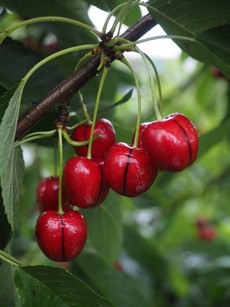 It may look like someone took a pen and drew the little black line on the Natalie cherry. But nothing is further from the truth. "The Natalie is a mutation of the popular Regina variety," says Toon Vanrykel of the Belgian company, DEPA-Fruit.
It may look like someone took a pen and drew the little black line on the Natalie cherry. But nothing is further from the truth. "The Natalie is a mutation of the popular Regina variety," says Toon Vanrykel of the Belgian company, DEPA-Fruit.
"Its appearance is unique. There is nothing comparable on the market. The market has dark cherries and bi-colored cherries. But, there is not yet a red cherry with a black line."
“The Natalie is a new variety. It was discovered years ago in Germany. There, a grower, working with the Bayoz breeding company, stabilized and developed the breed. We have now started establishing the first trees," Toon explains.
"From the next planting season, we will have large volumes of Natalie cherries available. This year, from November, there will be smaller quantities. As mentioned, the Natalie is a Regina mutation. This means it tastes as sweet as the Regina. Regarding its type of tree, it is also an easy breed to cultivate."
"The difficulty in cultivating varieties from, for example, Canada or America, is often underestimated. We know this from experience. It is also challenging to grow white cherries. This demand specialization. That is why it is ideal that cultivating the Natalie is as easy as growing the Regina,” Toon goes on to say.
Niche market
“We have had a lot of extremely positive reactions from the trade sector to this new cherry variety. Despite this, we are proceeding with caution. We realize that this cherry will find its place mainly in the niche market. However, we are getting inquiries from growers all over the world. They would love to have trees."
We are going to cultivate the first trees mainly in Belgium, the Netherlands, France, and Germany." Vanrykel continues. According to this tree grower, a great deal has been invested in new varieties in recent years. But getting a new breed onto market involves a lot of practical experience.
“A farmer takes the most risk when he decides to cultivate a new variety. This risk is why we are opting for certainty. We will not be dragged along with all kinds of new things," he says.
Cultivating and sorting
Besides the tree nursery, DEPA-Fruit also grows cherries. "We have about 10 hectares of cherries. But a lot of this is still young trees. They are not yet in full production. This week we started with the first early cherries. However, large volumes of these will be picked next week."
"Up to now, the cherries have looked very good - especially those growing under cover. We cultivate trees and grow and sort fruit. We also trade in sorted cherries. This year, we have introduced new packaging. With this, we make a clear distinction between protected and non-protected cherries," concludes Vanrykel.
For more information:
Peter Durlet
Toon Vanrykel DEPA-Fruit
DEPA-Fruit
74 Tegelrij Street
3850 Nieuwerkerken
Belgium
+32 (0) 478 989 845
[email protected]
www.depa-fruit.be
